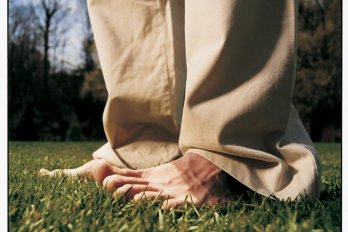THE CRUCIAL moment in Jean-Louis Bourgeois’s training as a West African clown occurred during the annual post-Ramadan festival, when two dancing women, themselves clowns, burst into his house in the ancient Malian city of Djenné. The visit in itself was not unusual; a wide variety of people drop by Bourgeois’s house daily. But on this occasion, one of the visitors had a wooden phallus on a string dangling from her waist. Bourgeois thought this was very funny and persuaded her to sell it to him. A few weeks later, Djenné’s foremost clown, Tabacily Coulibaly, came to visit. Coulibaly was Bourgeois’s teacher; his lessons had consisted mainly of the trading back and forth of Malian jokes. Now, after a year of practice, Bourgeois was ready to show his teacher that he had mastered this very particular brand of humour. “I had an inkling that Coulibaly was not stopping by just to say hello,” Bourgeois recalls. “He wanted to check what progress I had made as his apprentice. He was giving me a clown exam.” Bourgeois fetched the phallus from his room and dangled it before Coulibaly, who laughed and anointed him as an official Malian clown.
In Western society, clowns are relegated to the circus and the comedy club; in Djenné, they play an important role in everyday life. Clowns are generally members of the Woloso caste, which is comprised of the former domestic slaves of various West African tribes, such as the Fulani and the Songhai.
Despite their low social status, Djenné’s clowns, like the fools and jesters in Shakespearean drama, are permitted to do or say almost anything. According to some anthropologists, the antics of the Woloso clowns help to relieve stress in a highly formal culture. Woloso clowns also play an unofficial role in helping to resolve disputes and conflicts in Djenné’s stratified society. One way they do this is to tease both the opponent parties mercilessly. But, if need be, they will also strip off their clothes and dance naked to defuse a hostile situation.
It is unusual for someone who is not of West African descent to become a Woloso clown. (Typically there is no formal education; one learns by observing one’s elders, and lineage and a sense of humour are the main criteria.) But, with his sense of adventure and his cultural pedigree, Bourgeois is better suited to the task than most. His father, Robert Goldwater, a renowned art historian, was the director of the Museum of Primitive Art in New York and wrote seminal treatises on African sculpture. His mother, the world-famous sculptor Louise Bourgeois, has something of a Woloso sense of humour herself, according to Jean-Louis. One of Robert Mapplethorpe’s most famous photographs shows her smiling, with a huge latex phallus tucked under her arm. (She titled the phallus “Fillette,” French for a young and inexperienced girl.)
Bourgeois was already something of a clown before he became a Woloso. His leathery skin and intense blue eyes give him a distinctive appearance, though it is his attire that really stops traffic. The pony-tailed sixty-three-year-old wears a fantastic array of Malian adornments around his neck, including a leather Tureg wallet, a silver chain with an enormous blue stone, and a cowrie-shell necklace. His favourite outfit consists of printed indigo tunic and pants. His preferred accessories are an out-sized blue-foam cowboy hat and a Winnie-the-Pooh tote bag. When he attended an environmental conference in Brazil, he was asked by a schoolgirl if he was still in kindergarten. (Bourgeois answered, “Yes, but I have been going for quite some time.”)
Bourgeois first travelled to Djenné in 1980 as part of a decade-long trip he took with his wife, the late Carollee Pelos, to research a book on adobe architecture. Bourgeois had studied architecture and literature at Harvard University (he enrolled in 1958 and graduated in 1978) and worked for the prominent arts magazine ArtForum. He decided to focus on adobe after reading Bernard Rudofsky’s Architecture Without Architects, which argues that architecture should not dominate Nature and should be treated as a craft rather than as a profession.
Bourgeois and Pelos’s odyssey took them through Asia, Africa, and the American Southwest. Their book, Spectacular Vernacular, which presents a cross-cultural history of adobe architecture, was well received, and established Bourgeois as an authority on the subject. He now divides his time between Djenné and Taos, two of the most significant adobe communities in the world, and both World Heritage Sites.
To visit Bourgeois in Djenné is to leave the modern world. The town is thirty kilometres from the narrow, two-lane road that is one of Mali’s major highways. Bourgeois’s rustic, two-storey house has uneven adobe floors and no flush toilet. Scrawny chickens run about in the small courtyard. Looking out from the terrace, one can observe a way of life that has changed little over thousands of years: fishermen cast their nets from long, slim canoes that ply the Bani River; herds of cattle graze on the nine-feet-high aquatic grass.
One of the oldest cities in sub-Saharan Africa, Djenné dates back to 250 B.C. It has the world’s largest adobe structure – a mosque capable of holding two thousand people – and many tall adobe buildings with bulging, priapic finials, saw-toothed roof decorations, and intricate, latticed wood windows. Most of the city’s winding dirt streets have open sewers for “grey” water (as opposed to “black” water, which contains sewage), and are too narrow for Djenné’s few automobiles.
The lack of modern amenities appeals to Bourgeois, but so does the region’s complex social structure, which dates back several millennia and has survived a number of African empires and colonization by the French. The idea we encounter in history books in the West, says Bourgeois, “is that civilization equals empire. Now we know that in the Niger and Bani river basins there is instead another civilization, where different groups co-operated.”
The clown is a key figure in this social order. Social humour in general is highly prized in Mali, much of it revolving around differences in power and status – issues over which tribes in neighbouring African countries such as Sierra Leone (and in the rest of the world, for that matter) frequently go to war. In Mali, some of the most spirited joking takes place between individuals who are “teasing cousins.” Usually a clan has “teasing” relations with four or five other clans within or outside of its tribe.
Bourgeois says the jokes generally revolve around who is a slave to whom, or who “created” another tribe in West African history. The custom is a light-hearted way for Malians of diverse ethnic backgrounds to get acquainted. But it also pokes fun at the hierarchical social order that affects everything from a person’s livelihood to whom he or she can date.
A Woloso clown is able to be more freewheeling in his or her humour than most. Often, when Bourgeois enters a store or gets stopped at one of the many police roadblocks on the road to Djenné, he identifies himself by his Malian name, Baber Maïga, which provokes a slew of slave and creation jokes. In a typical riff, a member of the Dogon Tribe might say, “I know a cave where the Dogon use a stone to make Maïga,” to which Bourgeois might reply, “I have a tree where every night the fruit becomes Dogon.” To give his jokes additional bite, Bourgeois sometimes pretends to whip people with a little leather whip used by Koranic teachers in South Eastern Mali to discipline disobedient students.
One of Bourgeois’s favourite activities consists of sitting on a stool on the dirt road in front of his house in Djenné, bantering with fellow Woloso clowns, members of various tribes, and the occasional tourist. (Clowning is not paid work, and Bourgeois appears to be independently wealthy.)
Among close friends, conversation is even more relaxed, and Bourgeois has come to consider the exchange of such pleasantries as “How is your penis today?” or “Have you washed this morning?” (a euphemism for “Have you made love?”) – both common in Mali–profoundly more natural than the social niceties of the modern Western world.
Of late, Bourgeois has turned from aesthete to entertainer to relentless activist. In some ways he is trying to modernize Djenné; he has, for instance, helped finance a campaign to elect the city’s first woman mayor. In the main, however, he is trying to preserve the city’s traditional culture. He has agitated (unsuccessfully) against a paved highway being built to connect Djenné with the rest of Mali, as well as the project to build a modern sewage system that he says will waste water, a precious resource for most of the continent. His biggest struggle is against the Talo Dam project, which would divert water from Djenné. Bourgeois says the dam is an example of Lewis Mumford’s concept of the “megamachine” – a system imposed by an authority from outside that will ruin the local ecology and reduce tens of thousands of people to starvation.
Bourgeois’s campaign included funding a study on the proposed dam, and appeals to the U.S. government, a member of the African Development Bank (ADB), the multilateral institution financing the project. In 2001, the U.S. Treasury Department took the highly unusual step of prevailing upon the ADB to place a temporary moratorium on the project, even though it had already received approval from the bank’s board. Despite Bourgeois’s efforts, the project is now going ahead, supposedly with more community involvement and a dam design that diverts less water from Djenné.
Because of his activism, Bourgeois is a prominent, if somewhat controversial, figure in Djenné. He has faced attacks from public officials, and been accused of sleeping in the cemetery and performing black magic. But he has also received some of the city’s highest honours. He was declared an “epic hero” by the late head of the influential community of griots, who serve as the country’s oral historians. And the king of Djenné has adopted him as a son. Bourgeois often carries a brass-tipped ebony staff called a Tankara, which indicates his quasi-royal status. (Unfortunately for Bourgeois, his royal status does not provide him with any real political power, because in recent years Djenné’s mayor has superseded the king as the city’s de facto ruler.)
Of all of his diverse roles, Bourgeois believes being a Woloso clown is the most important. He says that in the West, it was once the work of intellectuals to call attention to abuses of power; he sees Woloso clowns performing this function in Mali today. By becoming a Woloso, Bourgeois has found a position, not available to him in the West, where he can both indulge his eccentricities and support his social agendas. “We are off the social scale; we are not members of conventional society; we are not Bourgeois,” he says with characteristic wit. “The Woloso have the freedom to be outrageous. They are free to tell the truth.”






